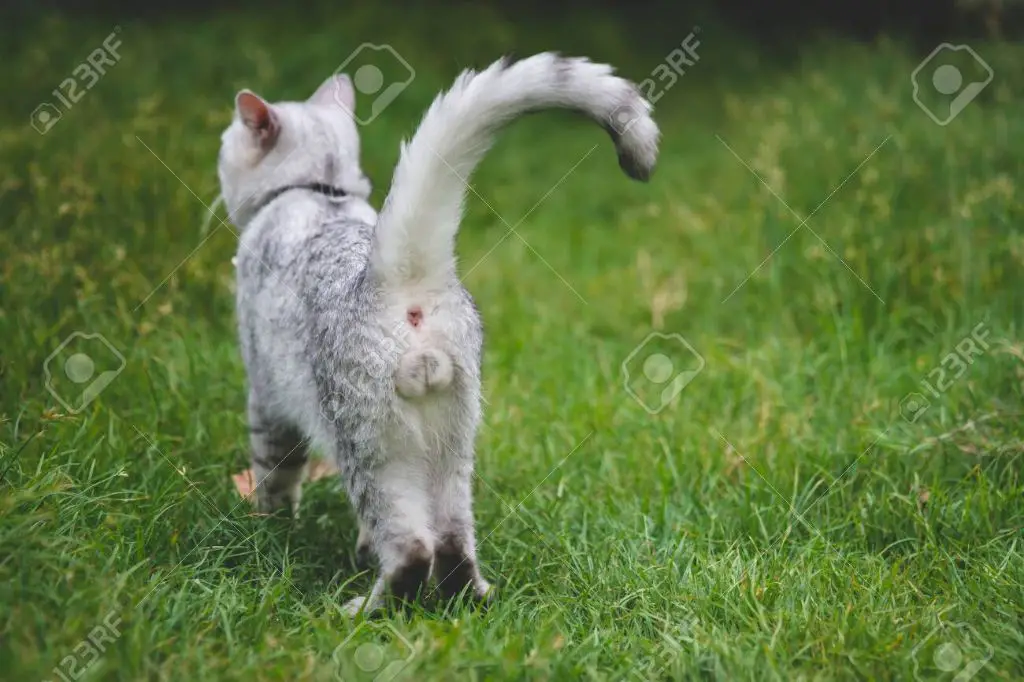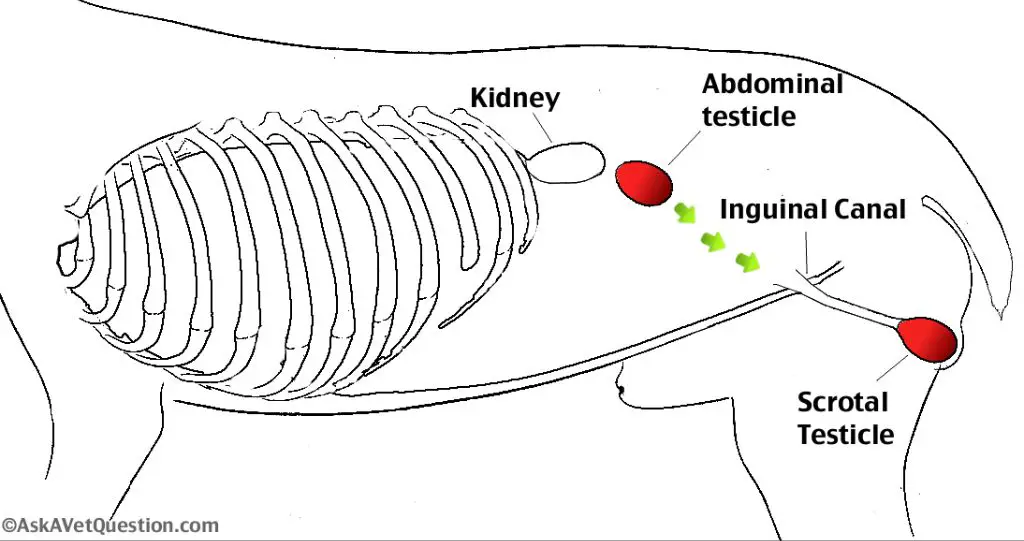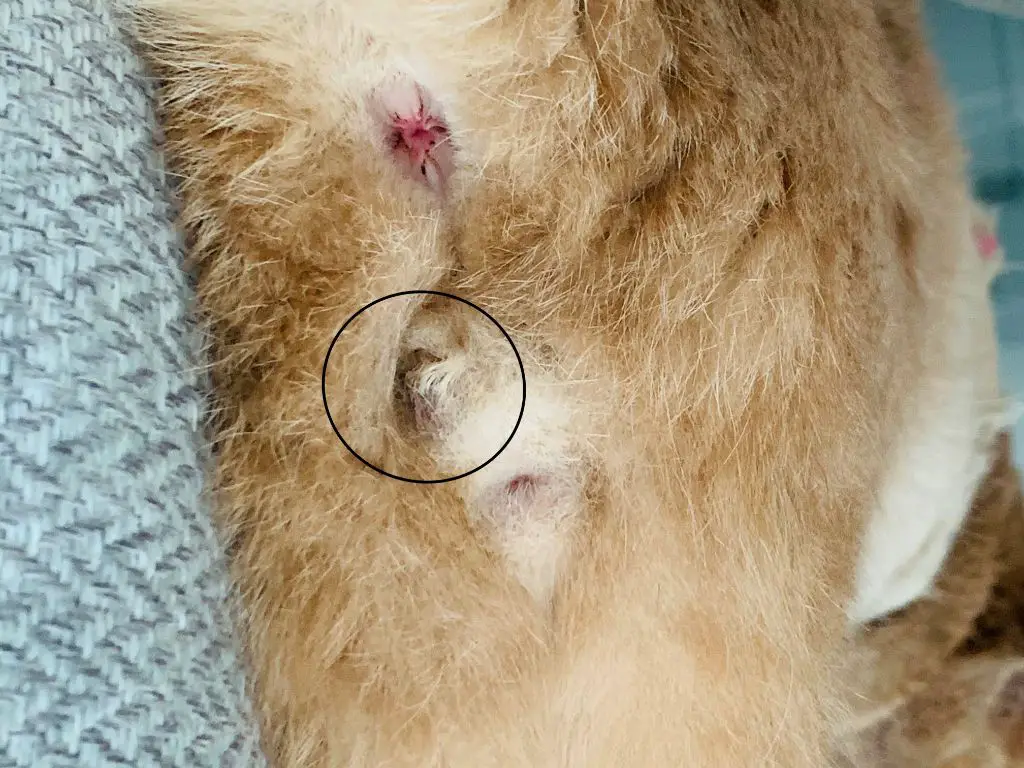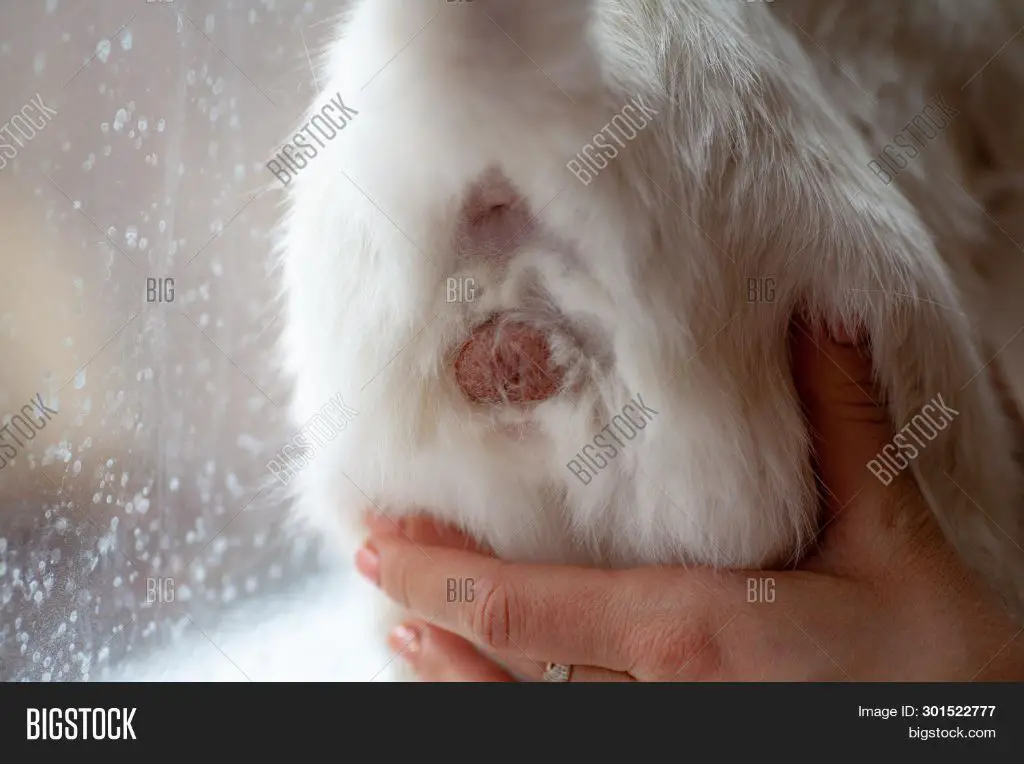Anatomy of Feline Testicles
In male cats, the testicles are located outside the body in a thin sac of skin called the scrotum. The scrotum is located ventral to the anus, between the hind legs. Within the scrotum, each testicle is enclosed in its own compartment separated by a median septum (Johnson, 2022).
The testicles descend into the scrotum during kittenhood, usually between 2-6 months of age. The descent of the testicles is an important part of normal male reproductive development (VIN, n.d.).
Each testicle contains seminiferous tubules where sperm are produced, as well as interstitial cells that secrete testosterone. The epididymis stores and transports sperm from the testes. The sperm then passes through the vas deferens and out through the penis during ejaculation (Johnson, 2022).
Appearance and Size
A cat’s testicles are located inside a furry pouch called the scrotal sac, which hangs below the anus. The testicles are oval-shaped glands that produce sperm and male hormones like testosterone. At birth, kitten testicles are very small, around 0.12 inches (3 mm) long and weigh just 0.005–0.01 ounces (150–300 mg) [1].
Testicles grow rapidly as male kittens mature. By 6 months of age, cat testicles are around 0.6–0.8 inches (15–20 mm) long and weigh around 0.14–0.28 ounces (4–8 g). Adult cat testicles continue growing until the cat is around one year old, reaching a size of 0.8–1.2 inches (20–30 mm) in length. However, testicle size varies based on the breed. Larger cat breeds tend to have bigger testicles than smaller cat breeds.[2]

Cat testicles are covered in a thin layer of pinkish skin. The surface has a smooth texture with subtle wrinkles. The testicles should be oval shaped, firm, and symmetrical without any lumps or swelling. Each testicle is connected to the abdomen by a spermatic cord that provides nerve connections and blood supply.
There are two testicles within the scrotal sac. Having only one descended testicle (cryptorchidism) is abnormal and can signal an underlying health problem. If the testicles appear misshapen, swollen, or feel hard, tender, or uneven, veterinary attention is recommended.
Changes with Age
A cat’s testicles develop and grow dramatically as the cat matures from kitten to adult. According to research by Elcock (1984) https://pubmed.ncbi.nlm.nih.gov/6524733/, kitten testicles start out small, with an average length of just 0.8 cm at 2 months old. By 6 months of age, the testicles have grown to an average of 1.6 cm long. Adult cats typically reach full testicular maturity by around 10-12 months old, when the testicles reach an average length of 2 cm.
As male cats reach full sexual maturity, their testicles descend fully into the scrotal sac. The testicular tunics also thicken with age. Sperm production ramps up during puberty, leading to larger, more developed testicles. According to Johnson (2022) https://journals.sagepub.com/doi/full/10.1177/1098612X221079707, sperm quality and fertility tend to peak when cats are 2-6 years old. Older cats over 10 years in age may have smaller, softer testicles and lower sperm counts, but can often still remain fertile.
Variations Between Breeds
There can be some differences in testicle size and appearance between cat breeds. Some key points:
- Larger cat breeds like Maine Coons tend to have larger testicles than smaller breeds like Siamese cats.
- Testicle size is proportional to the size of the cat. Large breeds have larger testes and small breeds have smaller testes relative to their body size.
- The shape of the testicles can vary slightly between breeds. Some breeds may have more oval shaped testicles while others are more rounded.
- Folded-ear breeds like Scottish Folds often have testicles that are more rounded in appearance.
- Hair length around the testicles varies. Long-haired breeds like Persians have more hair covering the scrotum area.
- Color of the scrotum and testicles is usually darker in color for breeds with darker coat colors.
While there are some visible differences, the variations in the appearance of cat testicles across breeds are relatively minor. The overall anatomy remains quite similar. Any significant deviations from normal size or shape could indicate an underlying health issue.
Cryptorchidism
Cryptorchidism, also known as undescended testicle, refers to the condition where one or both testicles fail to descend into the scrotum during fetal development. This can occur in either one testicle (unilateral cryptorchidism) or both testicles (bilateral cryptorchidism). Cryptorchidism is fairly common in cats, occurring in up to 10% of male kittens.[1]

In normal prenatal development, the testicles form inside the abdomen near the kidneys. As the kitten matures in utero, the testicles gradually descend through the inguinal canal into the scrotal sac. In cryptorchid cats, this descent is interrupted for unknown reasons. The undescended testicle(s) can be located anywhere along the path of descent from high up in the abdomen to just outside the scrotal sac.
Retained testicles do not function normally and are prone to twisting, inflammation, and developing cancerous tumors later in life. For this reason, neutering is strongly recommended for cryptorchid cats. The surgery may be more complicated than routine castration, often requiring an abdominal incision to locate and remove the retained testicle(s).
Signs of cryptorchidism include a scrotum that appears small, uneven, or empty on one or both sides. There may be a small lump along the inguinal canal where a testicle is trapped. Cryptorchidism can occur alongside other congenital disorders like umbilical hernia. Diagnosis is made by physical examination of the cat’s abdomen and scrotum.[2]
While the condition does not typically cause discomfort in itself, the long-term risks make timely neutering important for health. Cat owners who suspect their pet may be cryptorchid should consult their veterinarian.
[1] https://pethealthnetwork.com/cat-health/cat-diseases-conditions-a-z/retained-testicles-cats-and-kittens
[2] https://wagwalking.com/cat/condition/cryptorchidism
Testicular Cancer
Testicular cancer is rare in cats, with only a few cases reported in veterinary literature. The most common signs and symptoms of testicular cancer in cats include:
- Enlarged or asymmetric testicles – One testicle may be abnormally large or misshapen compared to the other
- Firm, irregular masses or nodules on the testes
- Evidence of pain or discomfort in the groin area
- Difficulty urinating or defecating
- Blood in the urine
- Abdominal swelling or distension
- Lethargy, weakness, or weight loss
The two most common types of testicular tumors in cats are interstitial cell tumors and Sertoli cell tumors. These masses are often fast growing and can spread to other parts of the body. Early detection and surgical removal of affected testicles offers the best prognosis.
Owners should monitor their cat’s testicles regularly for any abnormal enlargement, hardness, or asymmetry. Rapid tumor growth or sudden onset of clinical signs warrants immediate veterinary evaluation. Ultrasound, bloodwork, urinalysis, and biopsy help diagnose testicular cancer in cats.
Castration
Castration, also known as neutering, is the surgical removal of a male cat’s testicles. This procedure is commonly performed on household pet cats to prevent reproduction and reduce certain male behaviors like spraying and aggression [1]. After neutering surgery, the scrotum will appear shrunken or completely flat as the testicles are no longer present.

Right after the neutering procedure, the scrotal area may be shaved and have a surgical incision that is closed with dissolvable sutures under the skin. As the incision heals over the next 7-14 days, swelling and bruising of the scrotum may be visible. The scrotum will get smaller as internal bleeding and inflammation resolve [2].
Within 1-2 months after neutering, the scrotum will be completely empty of testicles and significantly atrophied. Some cats may retain a small flap of redundant scrotal skin, while in others the scrotum shrinks into the body and becomes nearly flush with the surrounding skin. The scar from the neutering incision is typically faint and difficult to detect by 6 weeks post-surgery.
Care and Hygiene
Proper care and hygiene after a cat is neutered is essential for a smooth recovery. Cleanliness helps prevent infection and supports healing of the incision site.
It’s important to keep the incision area clean during the recovery period. The area should be checked daily for signs of swelling, discharge or bleeding. Gently wiping around the affected area with a warm, wet cloth can help keep it free of dirt and debris.
Your veterinarian may recommend using an Elizabethan collar to prevent licking or biting at the incision site. Licking can introduce bacteria and delay healing. The collar should be worn continuously until the incision has fully closed, usually 7-10 days.
Your vet may prescribe antibiotics or pain medication to aid recovery. Be sure to carefully follow dosage instructions. Limit activity levels for 7-10 days post-surgery to allow proper healing.
Contact your veterinarian if you notice any abnormal discharge, swelling or signs of pain around the incision. With proper hygiene and care, neutered cats typically heal quickly and avoid complications.
When to Seek Veterinary Care
There are certain changes in your cat’s testicles that warrant a veterinary visit. According to WagWalking, you should contact your vet if you notice:
- Swelling of one or both testicles
- Redness, tenderness, or warmth around the scrotum
- Difficulty urinating or defecating
- Loss of appetite or lethargy
- Blood in the urine
- Fever
- Vomiting or diarrhea
- Enlarged abdomen
- Weight loss
- Bad breath
- Increased drinking or urination
These signs may indicate an infection, cancer, or other medical issue requiring veterinary attention. It’s important to monitor your cat’s testicles and alert your vet to any abnormalities. Prompt diagnosis and treatment can help manage testicular problems before they become severe.
Frequently Asked Questions
Cat owners often have questions about the appearance and function of their cat’s testicles. Here are answers to some of the most common questions:
What do normal cat testicles look like?

Healthy cat testicles are oval-shaped and about the size of a grape. They are covered in a layer of loose skin that allows them to move freely in the scrotum. Testicles are located outside the body in a sac called the scrotum. This keeps them a few degrees cooler than normal body temperature for proper sperm development. The scrotum appears as a bulge between the hind legs.
How do cat testicles change as cats age?
Kittens are born with testicles inside their abdomen. The testicles descend into the scrotum as they grow, usually by 2-3 months of age. As cats reach sexual maturity around 6-10 months, the testicles finish growing and reach full size. In older male cats, the testicles may shrink somewhat in size.
Do testicle size and shape vary between breeds?
Yes, there can be minor variations in testicle size and shape between breeds. For example, Maine Coon cats tend to have slightly larger testicles than a Siamese cat. But in general, testicle size correlates with the cat’s body size – a larger cat will have proportionally larger testicles. As long as they are oval-shaped and move freely, minor variations in size or shape are normal.
Why do cat owners have cat testicles removed?
The most common reason cat owners choose to neuter their male cats is to prevent unwanted litters. Neutering eliminates the production of sperm and testosterone, reducing roaming, urine spraying, and aggression associated with mating behaviors. There are also some health benefits like reducing the small risk of testicular tumors later in life. Talk to your veterinarian about the pros and cons of neutering.
